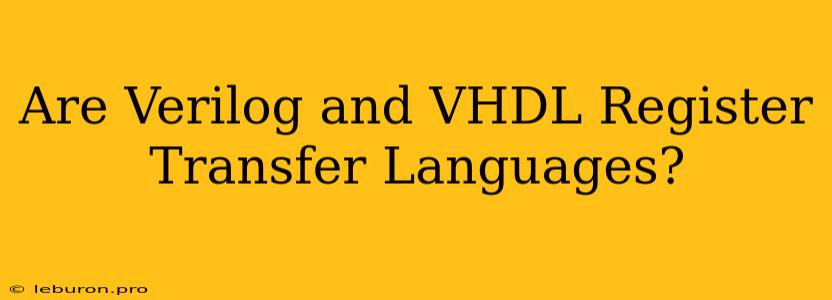Verilog and VHDL are widely used hardware description languages (HDLs) in the field of electronic design automation (EDA). They are instrumental in designing and simulating digital circuits, including everything from simple logic gates to complex microprocessors. A common question arises: Are Verilog and VHDL register transfer languages (RTLs)? While both languages possess RTL capabilities, they are not strictly limited to RTL design. This article delves deeper into the nature of Verilog and VHDL, exploring their RTL features and capabilities, as well as their potential for other levels of abstraction.
Understanding Register Transfer Languages (RTLs)
An RTL is a specific type of hardware description language that captures the behavior of a digital circuit at the level of registers and data transfers between them. RTL designs focus on the flow of data within a circuit, specifying how data is moved between registers, processed by logic units, and ultimately outputted. This level of abstraction is ideal for describing the functional behavior of a system without delving into the low-level details of specific gate implementations.
Verilog and VHDL as RTL Languages
Verilog and VHDL offer a rich set of features that make them well-suited for RTL design. Some of the key aspects that highlight their RTL capabilities include:
1. Data Types and Operations
Both languages provide a range of data types suitable for representing digital signals, such as:
- Bits and vectors: To represent individual bits or groups of bits.
- Integers and reals: To represent numerical values for calculations.
- Enumerated types: To define user-defined data types for specific applications.
These data types enable the representation of data within registers and the definition of logic operations that process this data.
2. Registers and Memory Elements
RTL design heavily relies on registers, which are memory elements that store data within a circuit. Both Verilog and VHDL allow the declaration and manipulation of registers using constructs like:
regin Verilogsignalin VHDL
These keywords designate variables that represent registers, enabling the storage and manipulation of data within a design.
3. Assignment Statements
RTL design involves defining the transfer of data between registers, logic units, and output ports. Verilog and VHDL provide assignment statements for this purpose, allowing the description of data flow:
assignin Verilog: For continuous assignments, often used for combinatorial logic.<=in Verilog: For non-blocking assignments, used for sequential logic.<=in VHDL: For concurrent assignment, used for both combinatorial and sequential logic.
These statements facilitate the description of data transfers and operations within a circuit.
4. Behavioral Modeling
Verilog and VHDL provide constructs for describing the behavior of a circuit at a higher level of abstraction, without necessarily specifying the exact gate-level implementation. This allows designers to focus on the intended functionality without being tied to specific hardware details.
5. Control Flow Constructs
RTL design often requires the implementation of control flow, allowing different actions to be performed based on specific conditions. Both Verilog and VHDL support control flow constructs, including:
if-elsestatementscasestatementsforandwhileloops
These constructs enable the creation of conditional logic and the implementation of complex state machines.
Beyond RTL: The Versatility of Verilog and VHDL
While Verilog and VHDL excel at RTL design, their capabilities extend beyond that level of abstraction. These languages can also be used for:
1. Gate-Level Design
Verilog and VHDL allow designers to describe circuits at the level of individual logic gates, such as AND, OR, NOT, XOR, and more. This level of detail is often necessary for fine-grained control over the hardware implementation or when optimizing for specific performance characteristics.
2. System-Level Design
Both languages provide constructs for describing systems at a higher level of abstraction than RTL. This allows for the modeling of complex systems composed of multiple interconnected modules, including:
- SystemVerilog: An extension of Verilog that includes features for system-level design and verification.
- VHDL for system modeling: VHDL supports concepts like packages, entities, architectures, and configurations, enabling the modular design and hierarchical organization of complex systems.
3. Testbench Development
Verilog and VHDL are also used for creating testbenches, which are simulations used to verify the functionality of a designed circuit. Testbenches can be implemented at various levels of abstraction, depending on the specific needs of the verification process.
Conclusion: Are Verilog and VHDL RTLs?
In conclusion, Verilog and VHDL are not strictly limited to register transfer language (RTL) design. While they possess powerful features for RTL modeling, they also encompass a broader range of abstraction levels, including gate-level design, system-level design, and testbench development. The choice of abstraction level often depends on the specific design requirements, the desired level of detail, and the tools used for implementation and verification.
Despite their versatility, Verilog and VHDL remain essential tools for hardware designers, providing the flexibility to model and simulate digital circuits at various levels of complexity, ensuring efficient design and verification processes.
